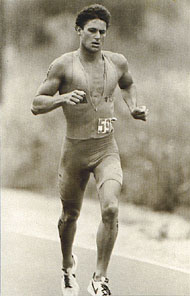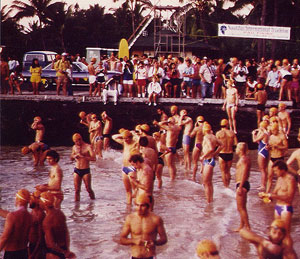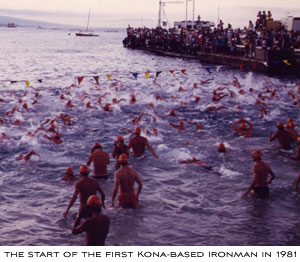The first Kona Ironman: A retrospective blog (Part I)
I first heard about the Ironman from a lifeguard buddy in 1978. My impression was, what a crazy thing to do, like climbing Everest, or base jumping El Capitan; it just seemed stupid to me. But it did intrigue me as I was a competitive multisporter of sorts, but the lifeguarding kind.
Our lifeguard-specific event, ironically called the Ironman, consisted of running, swimming, paddling, and rowing, all done in about 30 minutes or less. I had realized early on that I could be quite good at an aggregation of sports, but not great at any single sport. I gravitated to the run-swim-run events, as well as lifeguard's Ironman. Combining swimming, cycling, and running caught my interest, but I'd never ridden a bike before. Also, I hadn't run more than a mile, and that was barefoot in the soft sand.
I convinced a couple of my lifeguard buddies, Kim Bushong and Jeff Jones, to take up this new sport with me. In 1979 we all bought our first bikes, and flew to New Zealand to ride around both islands for training. We had no idea what we were doing. We just loaded up the bikes with 80 pounds of camping gear, wore shorts that Kim's mom made for us, and we took off with a map of the island and the dreams of young, naive, kids.

Three months later we returned jazzed on cycling, and upon hitting Stateside were informed that a fellow swim specialist, from Davis, California, had won that year's Ironman. The three of us jumped into bike racing and began to do the few triathlons that were held in California back then. I won my first 3 races and thought, this is my sport. It wasn't until then that the thought of racing in Hawaii formed in my brain, like that first grain of sand that one day becomes a pearl.
I had no idea that it would never be that pearl, but a big, ugly black marble instead.
The race in Hawaii was held on Oahu for the first 3 years, and was pretty much an underground event. Word had gotten out about it, and by 1980, there were about a hundred who wanted to give it a go. Through the disinterest of her husband the event's organizer, Valerie Silk, became the Ironman's de facto owner. Not wanting to deal with all the issues of circumnavigating the crowded island of Oahu, she chose to move the race to the sleepy town of Kailua-Kona. That first Kona-based race would be in February of 1981, and my lifeguard buddies and I were primed and ready to tackle it.
One of the older lifeguards owned a condo in Kona, right on Alli Drive. He paid about $30,000 for it, and rented it to us for $300 a month. Since the race was in North America's Winter back then, as part time lifeguards we had a lot of time off. We all decided to go three months early and scout out the course and get some surfing in. With very few dollars in-pocket, we found the local avocado, papaya, banana, and macadamia nut trees, and we largely lived off those. Once a week we would treat ourselves to the local all-you-can-eat joint for four bucks.
Those first months out there were great, all new routes, and no one on them except us. There was no real sport culture on the island, no bike shop, and just a little downtown at the pier. There were few big hotels out on the Queen K, and the south end of Kona was populated by a few condos and the Kona Surf Hotel. We met all the locals there, we were quite a novelty, and stood out like sore thumbs. Our daily routines were to ride or run, and then ride up the hill to the local high school to do a pool workout. We spent most of our time in the ocean surfing, so we enjoyed doing our swims in the pool. That is one big difference between then and today's October timing: there is actually a lot of big surf in the Winter there. We spent about 2 months like that, living off the land, exploring the entire island by bike and foot, and then the first of the new Ironmen began to arrive late in January.
By that time my buddy Kim had become legendary on the Island for his eating abilities. He began the day by making up a half-box of pancake mix, throwing the whole mess into a giant skillet, and then burning the outside, hardly cooking the inside. He would put half a jar of peanut butter on top, then a whole can of fruit cocktail. We figured it out to about 10,000 calories, and we called them "Mancakes.”
Kim was the cheapest guy I ever knew, and he would buy all this stuff in bulk. We threw a New Year's party, and made a 60-avocado batch of guacamole. No one showed up, so the 3 of us ate all of it, then finished with a 24 pack of Snickers bars. We figured out later that we each ate about 30,000 calories that day, most of it fat.
It was great fun to finally meet some of the new guys. There was George Yates and John Howard, two of the best American cyclists of that day. There was Ken Shirk, aka Cowman, a very young Scott Molina and Scott Tinley, and the legend, Tom "Tugs" Warren. And although I don't remember meeting him, Slowman himself was there, with all his hair, and that old 32-minute 10k speed, ready to take on the Ironman.
These characters were right out of Vonnegut novels. No wimps, no whiners, just the hardest of the hard core from around the world. During the prior year's Ironman Dave Scott showed that this event could be a race and not just a survival adventure. This was a sort of call to the best athletes the sport had to offer. Unfortunately for Dave, he would not defend his title, one of the many years he sat out due to injuries.
Since everything was new about the race, and every director and coordinator a rookie, it was produced in true laid back Hawaiian style. The head of the swim course had no idea what was entailed in laying out a swim course. Since we were lifeguards who'd produced many open water swims, he asked our council. Kim and I “swam out” the course, and using our time as a guide, we placed the turnaround marker. To this day, I still think this is the best way to measure a swim course for time accuracy. When you round that boat out in Kona's harbor, think of old Monty 27 years ago, telling them to drop it “right here.”
The bike course was handled by a local masters bike racer, and I'm sure he rolled it out in his car, which was off a bit, so we rode about 2 or 3 miles farther that the advertised 112. Two weeks before the race they held a USCF road race on the exact bike course, and about 50 guys from the other islands came over for the race.
George Yates, myself, one guy form Oahu, and Kim Bushong made a break at 80 miles or so, and finished in 4:23 for the 115 miles in that order. They would hold that race for the next two years, but then it faded out of the pre race program. Too bad, because I think it would be a very popular event, and it would just be fun to see all the pros riding head to head with nothing to lose. We'd probably see that sub-4-hour time out there if the Germans rode it.
One of the guys that we made friends with early on was John Howard. He was one of the best the US had ever produced in international bike racing, and he had done the race the year before. His only problem was that he swam a 1:51, and never got into the same zip code as Dave Scott. He had a condo right across the street from us, and we made a bargain to help him with his swim if he would help us with our riding. He had done a lot of work on just swimming the past year, but he had no open water experience. We were able to do a lot for him in the last couple weeks, and we then went on a course ride with John.
Understand that up until that point, Kim and I had raced bikes for one season, moved up from Cat 4 to Cat 2 in three months, and neither one of us had ever been dropped in training, or in a race. We didn't know what getting dropped was. we just got on the bike, raced off our swimming lungs, and did what everyone told us to do which was: stay with the leaders. We go on this ride with John, and his idea of helping us was to burn us off his wheel and make us suffer. We got to the turnaround, and both Kim and I were hammered, but we didn't get dropped. We could tell John was a little pissed, and maybe a bit worried, because I think he felt that he would dominate this race, especially the bike ride, against all of us novice riders. I think we were a little stronger than he had planned on.
After a quick lunch he dropped the hammer again, and around mile 90 we finally got dropped. We looked at each other, and said, so this is what it feels like to get dropped and bonked. We didn't like it. Next time we saw John was at dinner that night, and that was his lesson to us on the bike.
He gave me two things to remember that day: my first ass-whooping; and at dinner that night he asked what we took for supplements. Maybe a Flintstone vitamin once in awhile, I think I said. He replied that if we wanted to know anything about supplements just ask any bike racer, and then he said something in a generic way, not referring to himself. He said that there were drugs out there that would probably grant you a win at this race. It didn't resonate at the time – drugs were not a hot topic in that era. I never forgot that comment though, and it came to mean a lot more to me many years later.
Speaking of health and medicine, there were concerns for us back then, this whole thing just had everyone scared. They instituted a weigh-in procedure for the race. You would stop four times during the bike and run and they would check your body weight against your recorded pre-race weigh-in. If you lost more than 10 percent of your weight, you would be pulled from the race. This had us all worried, no one wanted to get pulled, and back then we just didn't know if you really lost that amount of weight you would be screwed anyway. This was a hot topic of conversation at Dig-me beach each day.
But as is my style, I endeavored to find the angle in the system. Weigh-in for your scratch weight would be on Wednesday afternoon. I got my buddies and John together and told them my plan. We would do a light run Wednesday morning, skip breakfast, and spend two hours in our sauna right before the weigh in. That way, we would knock off several pounds, and really have a more than a 10 percent cushion before getting pulled. Then just put it all back right after. It's funny when I look back at the TV coverage, where swim course commentator Diana Niadd, says, "These athletes are amazing, after the first 4 hours of racing, they have actually gained weight, what a testament to their superior abilities.”
To be continued…




Start the discussion at slowtwitch.northend.network